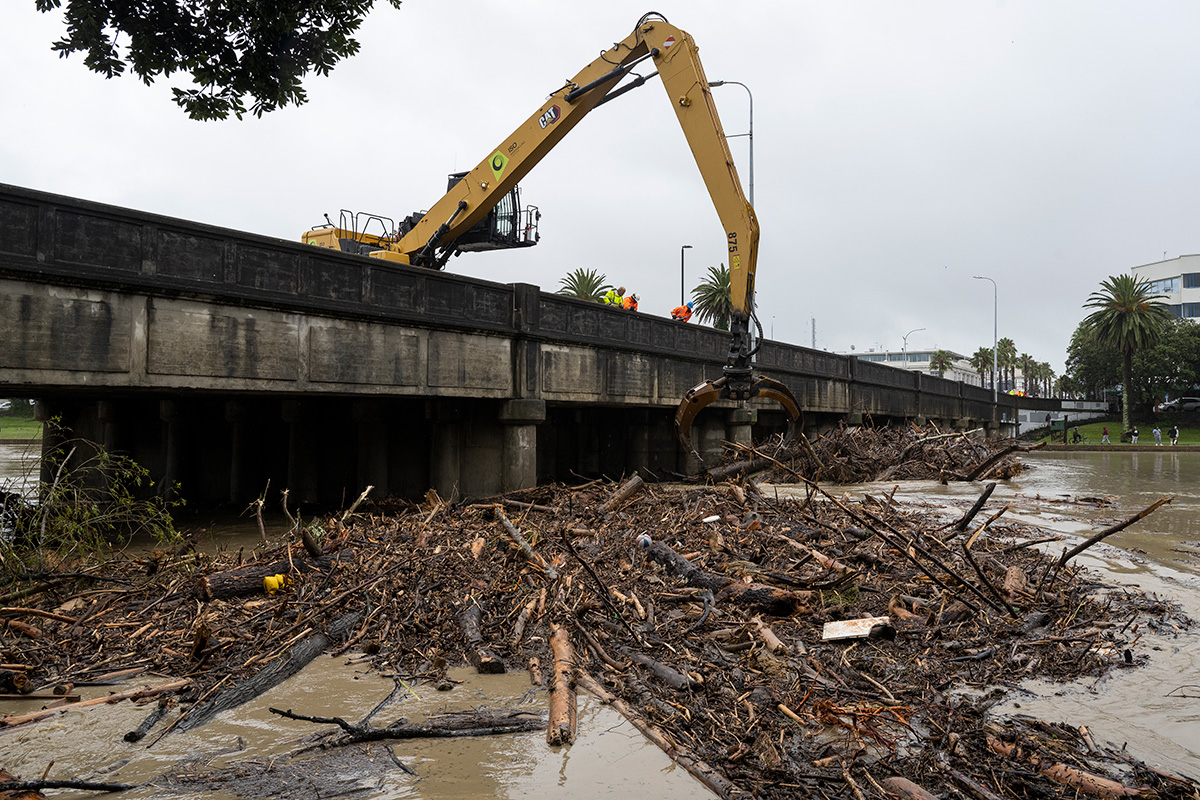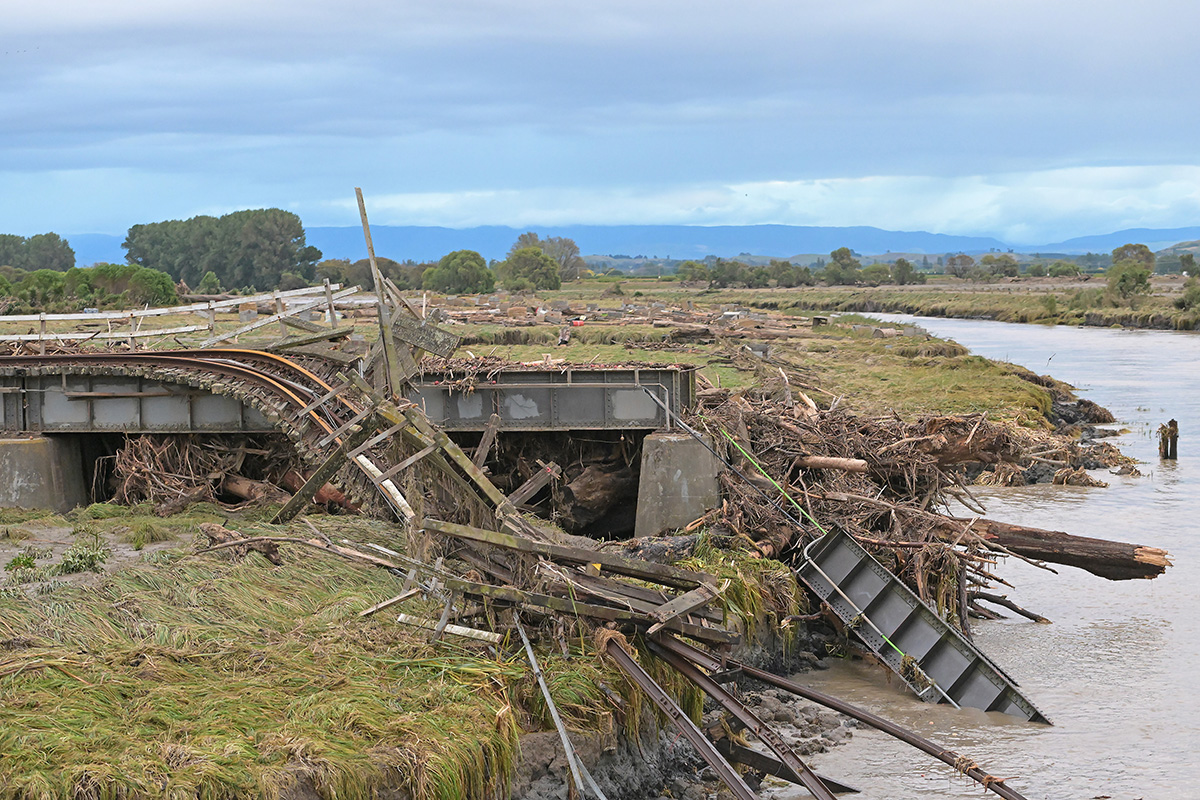When Lillian Te Hau-Ward saw the bridge that connects Tolaga Bay in Tairāwhiti to Tokomaru Bay had broken apart, she knew exactly what was to blame.
Piles of dead wood had swept down from pine forests and combined with flood waters to choke the river and the bridge crumbled under the pressure.
Te Hau-Ward is the Civil Defence coordinator for Tokomaru Bay and says the bridge would still be intact if not for all the wood.
The damage is so severe the town is now completely isolated from the rest of the country and helicopters are still the only way to get people and supplies in or out.
“We are feeling isolated and afraid,” she says. “It’s going to take years to recover.”

An excavator picks up forestry flash in Tairāwhiti. Photo: Phil Yeo/Getty Images.
This dead wood is called forestry slash - and it’s a huge problem.
Slash are the bits of log, wood and branches that are left over after logging.
Slash takes a long time to decompose, so this debris sits around for years and when there is heavy rainfall it gets swept down into towns and farmland and chokes up rivers and streams.
Slash can also be dangerous when it ends up on beaches. After Cyclone Hale, a boy died from a head injury after hitting his head on a log in the ocean.
“At the moment, we've been focusing on the devastation to the roads and infrastructure but it doesn’t stop there,” Te Hau-Ward says.
“There is all the sediment and silt that's coming down the waterways. So we've actually got an ecological and environmental disaster.”
Kai that would usually be foraged in rocks in the ocean is no longer there. And local cray fishermen haven’t caught their quota for the last four years, she says.
“And the ministry has just turned blind eye to all of this.”

Severe damage to the railway line at Awatoto, Napier. Photo: Kerry Marshall/Getty Images
Inquiry launched into forestry practices
Communities in Tairāwhiti have been calling for an urgent inquiry into forestry practices in the region for some time.
A petition started by Tairāwhiti resident Hera Ngata-Gibson has reached nearly 10,000 signatures. And earlier this month there was a collective decision to hold a major independent land use review in Tairāwhiti.
The Minister for Forestry Stuart Nash told Re: news he is open to a review of the industry and is currently “considering a way forward that includes the local community, iwi, and all stakeholders.”
On Thursday, The Forestry Owners Association, which represents the owners of New Zealand's commercial plantation forests, said they would also welcome an inquiry into forestry and land use in Tairāwhiti.
Te Hau-Ward says an inquiry will take too long and action needs to be taken urgently.
“We need studies to be done on our waterways now and solutions in place to remediate this damage.”
Is this a new problem?
Slash has been an ongoing concern in forestry towns like Coromandel, Tairāwhiti, Wairarapa, and Hawke’s Bay.
In June 2018, multiple forestry companies were ordered to pay between $124,000 and $378,000 to victims and communities to help clean up the damage caused by slash after severe weather events.
The Environment Court ruled the companies had not taken enough precautions to prevent slash being washed from the hills in Uawa Forest to Tolaga Bay’s rivers, streams, and coast.
Their lawyer said the offending was “careless” but “not reckless” because they had contributed to the clean-up and said it would not happen again.
But it did happen again. More than once.
Slash that was caught in rising water destroyed land, waterways, and infrastructure in Cyclone Hale in January and then again during Cyclone Gabrielle.
Te Hau-Ward says forestry companies responsible for this damage aren’t being fined anywhere near enough money to cover the cleanup of this damage.
Ernslaw earned $53.8 million from forestry between 2014 and 2018.
“We need to start imposing million-dollar fines on the owners of these blocks. Those fines weren’t enough and they took years to fight for.
“In the meantime, taxpayers and communities are paying for the cleanup.”
Re: News reached out to Ernslaw for comment but did not receive a response before the time of publication.
What is the slash solution?
"We need to ask some difficult questions about whether harvesting forestry is a reasonable activity in Tairāwhiti,” managing director at Climate Sigma, and manager of the Whakahura: Extreme Events and the Emergence of Climate Change Programme, Belinda Storey says.
Tairāwhiti has some of the most erodible soils in the world and is in the “direct firing line” of extreme weather events from climate change, she says.
One of the long-term solutions for minimising this damage is to replace logging forests with permanent native forests.
“Trees generally are able to hold precipitation and trap it. If you have a hillside covered in trees, it tends to flood less further down.
“If you cut down those trees and get an extreme event - debris from that harvesting gets mobile, and that water is not held in the hillside, it moves much faster because the hillside is bare,” she says.
Logging forests grow pine trees because they grow quickly and can be harvested at a fast rate to make the most profit.
“But if we accounted for all of the costs of a disaster, I suggest native forest blocks would start to pay off,” Storey says.
But a big consequence of this would be job losses in the area.
“We can’t close down forestry functions because lots of our whānau rely on it,” Te Hau-Ward says.
“If you don’t work in health or roading, forestry is really the only other big employer on the coast. It would affect us greatly.”
Instead, Te Hau-Ward says better practices to dispose of slash are needed which could include processing the forestry waste and passing it over to local communities to repurpose.
Environmental experts also need to be on hand in forestry teams at all times, she says.
But Te Hau-Ward has almost run out of hope that any new industries could be established in Tairāwhiti.
“We do have land that would have been great to grow crops, but our problem historically was access to water and good road networks. But now a lot of the good land is underwater and the roads are ruined”.
“It’s going to take years to recover.”
Top image: Forestry slash knocks out Hikuwai Bridge, north of Tolaga Bay, after Cyclone Gabrielle. Source: 1News.
More stories:
'It's all a write-off': Cyclone Gabrielle's damage in Hawke's Bay
“We knew it was coming and to be ready, but no one knew how bad it was going to be here.”
How to make the cheapest emergency kit: flatter's guide
To be ready for an emergency, you need to have at least three days of supplies at the ready.
‘Will I die waiting for health care?’: NZers rally for trans rights
Hundreds of people took to the streets of Tāmaki Makaurau and Pōneke last weekend.